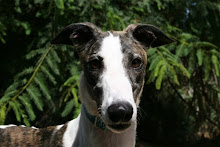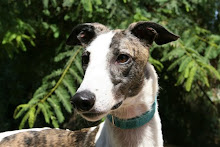In the Untied States, hundreds of thousands of dogs are homeless, or for other reasons, are in need of rescue. The story of any one of these dogs is heartbreaking. In some general way, I think most people hope that homes can be found for needy dogs. But the actual work involved in rescuing, rehabilitating and providing for the medical and routine needs of the lucky dogs who actually are received into a rescue is demanding--both emotionally and physically.
Every rescue has its story. And every rescuer has his or her story. I hope to tell many of these stories. But, since I am currently the guardian of two alumni of Greyhound Adoption Center, I decided to speak first with Marilyn, a volunteer with Greyhound Adoption Center, (GAC).
Portia's Mom: How long have you been associated with Greyhound Adoption Center?
Marilyn: I have been associated with Greyhound Adoption Center since 2001 when I adopted my first greyhound, Ariel (GAC's Ariel). Six months later, we adopted our second greyhound, Franklin (GAC's Bacardi) as a companion to Ariel after the death of our last cat.
PM: What got you interested in the plight of Greyhounds?
M: There was a very large, hugely handsome, red fawn, greyhound named BD (short for Bill's Dog) who graced our neighborhood for five years. BD's dad was retired and they walked faithfully, four times a day, rain or shine. Bill was my neighbor through whom I gained my initial insight into the plight of the racing greyhound. I was also very interested in pug rescue at the time, as another neighbor and a co-worker were heavily involved and there were several pugs in my neighborhood as well. My son was 17 at the time, my grandson 12. When the time was right to finally adopt, the boys vetoed the pug and having visited several humane societies and shelters, they thought we should adopt an Am Staff or Mastiff or a Lab or any mix thereof, because there were just so many such large dogs at each shelter. They were deeply saddened by this fact. However, when all was said and done, we decided to visit GAC's shelter and the rest is history. We were smitten.
PM: Did you have dogs or other pets as a child?
M: I did not have a dog as a child. I was raised in a very small farming community in Minnesota during the 1950's and early 60's. At that time, in a rural and small town setting, most of the dogs I knew were not pets; they were working dogs on farms. Very few people in town seemed to have a dog as a pet - cats were more prevalent, and cats were my childhood pets. I remember one very cute Boston Terrier running around the town every summer for several years. My dad owned a small grocery store and this little dog would come by asking for scraps. Dad said no, but my brother and I always fed him on the sly. From there my love of dogs began. And, witnessing the hard life of the farm dog, especially in the frigid winter, my heart was burdened, even as a small child. From that, my compassion for animals in need grew.
PM: What keeps you motivated?
M: Knowing there are still greyhounds numbering in the 10's of thousands that will need rescuing in years to come as the racing industry winds down, and knowing what happens to the greyhounds who are not on the lucky end when the rescue vans come calling, I am committed and movitated more than ever to do my share to help. Some of the work is hard and physically demanding, such as volunteering at the kennel for turn-out. Our rescue kennel houses 36 greyhounds in various stages of being readied for adoption. The dogs are turned out four times a day. Beds are straightened, soiled laundry is done, meals are prepared and served, medications are administered, floors and walls are scrubbed, and the cement turn-out areas outside are scrubbed and sanitized. Some dogs need lifting in and out of their crates. Dog food bags weigh 44 pounds. Most of the dogs are powerful and strong and pull when being escorted from their beds to the turn-out areas and back again, out the door and up ramps. But, the opportunity to work directly with the rescues from the time they arrive until adoption is a thrill beyond explanation. Some are very shy and watching them adjust and trust is just the best. Some come in with badly broken limbs, and assisting them as they recover, and taking them for their first walks after their legs heal, is beyond wonderful. Some are ill and nursing them back to health is indescribable. And, then being part of the adoption process is the icing on the cake, as I'm able to watch as they leave for their forever homes knowing in some small way, I was able to make a difference in their lives during their stay with us. Other volunteer opportunities, like participating in Show & Tells with our own greyhounds, and spreading the word, is just plain FUN!
PM: What is the most important thing you would like to tell people about Greyhounds? Greyhound rescue?
M: I would like people to know that the rescued, retired ex-racer is not the breed for everyone. I would like everyone interested in adopting one of these gentle, amazing dogs, to do their homework. Read everything available and make an informed decision. These are sighthounds with several thousand years of genetics bred into them involving hunting and chasing. Racing is a recent phenomenon - the instinct to run and chase is powerful. One may think if their greyhound does well in obedience training, and responds well to commands, including recall, that they may be trusted off-leash. Not so. Every adopter must be committed to maintaining the safety of their cherished adoptee for the life of the hound. That said, having completed their homework and coming to an informed decision that the greyhound is indeed the breed for them, come on in! For most of us who share our homes with an ex-racer, or greyhound mix, there is no going back. They are gentle, quiet, clean, funny souls who quickly race their way into our hearts and homes. They are generally a healthy breed; no inbreeding in the racers attributes to this factor.
Every dog in every shelter, regardless of pedigree, deserves a home. However, the plight of the greyhound is just a little different, in that excess dogs are intentionally over bred in an attempt to get a few good money makers. To the racing industry, the greyhound is nothing more than a commodity, a throw-away if you will, once racing out of the money. Mandatory retirement age is five, but puppies are culled and many racers are retired early because they get hurt, they are too easily distracted, or they are not fast enough. The rescue organizations worldwide do what they can, but the problem is just way too huge. Thus, thousands of these gentle dogs are disposed of each year, and not always by the most humane methods, through no fault of their own.
Thank you, Marilyn, for taking time to answer these questions. And thank you, especially, for all you have done to ameliorate the plight of the Greyhounds.
For further information about Greyhounds, a good place to start is the website of Greyhound Adoption Center
Subscribe to:
Post Comments (Atom)
.jpg)
.jpg)
.jpg)

No comments:
Post a Comment